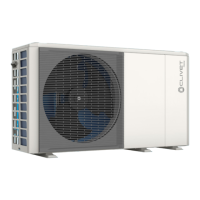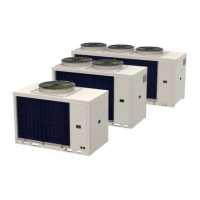Do you have a question about the CLIVET WiSAN-YME 1 S 8.1 and is the answer not in the manual?
Details general safety precautions, PPE, and qualified personnel requirements.
Identifies and illustrates the primary components of the unit across different sizes.
Lists the conditions the installation site must meet for optimal and safe operation.
Illustrates standard installation clearances and configurations for single/multiple units.
Provides guidance for installing the unit in areas exposed to strong winds or direct sunlight.
Details the procedure and dimensions for securing the unit to the ground using anchor bolts.
Outlines essential checks for the water circuit, pressure, and component compatibility.
Details measures to prevent ice formation in the water circuit, including antifreeze use.
Guides on ensuring adequate water volume and managing expansion tank pressure for system stability.
Lists safety precautions and recommendations for making electrical connections.
Details precautions and procedures for connecting the unit to the power supply.
Details the function and settings of dip-switches on the hydraulic module control board.
Introduces the HMI, its keypad functions, and basic interface navigation.
Guides on initial unit configuration, including DHW, cooling, heating, and auto modes.
Describes the function of each button on the HMI keypad for user interaction.
Details the meaning of icons and indicators displayed on the HMI screen.
Guides on adjusting system water and DHW temperatures using the HMI interface.
Describes how to select and manage the unit's operating modes (Heat, Cool, Auto).
Covers functions related to DHW production, including Disinfect, Fast DHW, Tank Heating, and Pump.
Lists error codes, their meanings, and corresponding MODBUS codes for troubleshooting.
Emphasizes safety checks for minimal ignition risk when working with flammable refrigerants.
Details the importance of using refrigerant detectors and checking for leaks.
Prohibits ignition sources and stresses inspection for flammability hazards before work.
Outlines the procedure for refrigerant removal, purging, and evacuation.
Details safe practices for extracting and handling refrigerant during recovery operations.
Provides a guide for diagnosing and correcting common unit issues when not heating or cooling.
Lists error codes, their meanings, and corrective actions for unit malfunctions.
Details general safety precautions, PPE, and qualified personnel requirements.
Identifies and illustrates the primary components of the unit across different sizes.
Lists the conditions the installation site must meet for optimal and safe operation.
Illustrates standard installation clearances and configurations for single/multiple units.
Provides guidance for installing the unit in areas exposed to strong winds or direct sunlight.
Details the procedure and dimensions for securing the unit to the ground using anchor bolts.
Outlines essential checks for the water circuit, pressure, and component compatibility.
Details measures to prevent ice formation in the water circuit, including antifreeze use.
Guides on ensuring adequate water volume and managing expansion tank pressure for system stability.
Lists safety precautions and recommendations for making electrical connections.
Details precautions and procedures for connecting the unit to the power supply.
Details the function and settings of dip-switches on the hydraulic module control board.
Introduces the HMI, its keypad functions, and basic interface navigation.
Guides on initial unit configuration, including DHW, cooling, heating, and auto modes.
Describes the function of each button on the HMI keypad for user interaction.
Details the meaning of icons and indicators displayed on the HMI screen.
Guides on adjusting system water and DHW temperatures using the HMI interface.
Describes how to select and manage the unit's operating modes (Heat, Cool, Auto).
Covers functions related to DHW production, including Disinfect, Fast DHW, Tank Heating, and Pump.
Lists error codes, their meanings, and corresponding MODBUS codes for troubleshooting.
Emphasizes safety checks for minimal ignition risk when working with flammable refrigerants.
Details the importance of using refrigerant detectors and checking for leaks.
Prohibits ignition sources and stresses inspection for flammability hazards before work.
Outlines the procedure for refrigerant removal, purging, and evacuation.
Details safe practices for extracting and handling refrigerant during recovery operations.
Provides a guide for diagnosing and correcting common unit issues when not heating or cooling.
Lists error codes, their meanings, and corrective actions for unit malfunctions.











